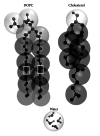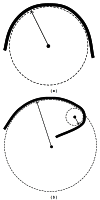Cholesterol induces uneven curvature of asymmetric lipid bilayers
- PMID: 23766730
- PMCID: PMC3671548
- DOI: 10.1155/2013/965230
Cholesterol induces uneven curvature of asymmetric lipid bilayers
Abstract
A remarkable flexibility is observed in biological membranes, which allows them to form the structures of different curvatures. We addressed the question of intrinsic ability of phospholipid membranes to form highly curved structures and the role of cholesterol in this process. The distribution of cholesterol in the highly curved asymmetric DOPC/DOPS lipid bilayer was investigated by the coarse-grained molecular dynamics simulations in the membrane patches with large aspect ratio. It is shown that cholesterol induces uneven membrane curvature promoting the formation of extended flattened regions of the membrane interleaved by sharp bends. It is shown that the affinity of cholesterol to anionic DOPS or neutral DOPC lipids is curvature dependent. The cholesterol prefers DOPS to DOPC in either planar or highly curved parts of the membrane. In contrast, in the narrow interval of moderate membrane curvatures this preference is inverted. Our data suggest that there is a complex self-consistent interplay between the membrane curvature and cholesterol distribution in the asymmetric lipid bilayers. The suggested new function of cholesterol may have a biological relevance.
Figures








Similar articles
-
Cholesterol behavior in asymmetric lipid bilayers: insights from molecular dynamics simulations.Methods Mol Biol. 2015;1232:291-306. doi: 10.1007/978-1-4939-1752-5_20. Methods Mol Biol. 2015. PMID: 25331142
-
Determination of mean and Gaussian curvatures of highly curved asymmetric lipid bilayers: the case study of the influence of cholesterol on the membrane shape.Phys Chem Chem Phys. 2014 Aug 28;16(32):17052-61. doi: 10.1039/c4cp01544d. Phys Chem Chem Phys. 2014. PMID: 25004951
-
How cholesterol is distributed between monolayers in asymmetric lipid membranes.Eur Biophys J. 2012 Dec;41(12):1043-54. doi: 10.1007/s00249-012-0863-z. Epub 2012 Oct 9. Eur Biophys J. 2012. PMID: 23052977
-
Molecular Dynamics Simulations of Curved Lipid Membranes.Int J Mol Sci. 2022 Jul 22;23(15):8098. doi: 10.3390/ijms23158098. Int J Mol Sci. 2022. PMID: 35897670 Free PMC article. Review.
-
Molecular Mechanisms Underlying Caveolin-1 Mediated Membrane Curvature.J Membr Biol. 2022 Jun;255(2-3):225-236. doi: 10.1007/s00232-022-00236-y. Epub 2022 Apr 25. J Membr Biol. 2022. PMID: 35467110 Review.
Cited by
-
Multiscale Simulations of Biological Membranes: The Challenge To Understand Biological Phenomena in a Living Substance.Chem Rev. 2019 May 8;119(9):5607-5774. doi: 10.1021/acs.chemrev.8b00538. Epub 2019 Mar 12. Chem Rev. 2019. PMID: 30859819 Free PMC article.
-
Determination of the shape and curvature of nonplanar lipid bilayers that are bent in a single plane in molecular dynamics simulations.J Mol Model. 2014 Apr;20(4):2176. doi: 10.1007/s00894-014-2176-x. Epub 2014 Mar 28. J Mol Model. 2014. PMID: 24676496
-
A mirror code for protein-cholesterol interactions in the two leaflets of biological membranes.Sci Rep. 2016 Feb 26;6:21907. doi: 10.1038/srep21907. Sci Rep. 2016. PMID: 26915987 Free PMC article.
-
EGFR oligomerization organizes kinase-active dimers into competent signalling platforms.Nat Commun. 2016 Oct 31;7:13307. doi: 10.1038/ncomms13307. Nat Commun. 2016. PMID: 27796308 Free PMC article.
-
Membrane Heterogeneity Controls Cellular Endocytic Trafficking.Front Cell Dev Biol. 2020 Aug 5;8:757. doi: 10.3389/fcell.2020.00757. eCollection 2020. Front Cell Dev Biol. 2020. PMID: 32850860 Free PMC article. Review.
References
-
- Ohvo-Rekilä H, Ramstedt B, Leppimäki P, Peter Slotte J. Cholesterol interactions with phospholipids in membranes. Progress in Lipid Research. 2002;41(1):66–97. - PubMed
-
- Róg T, Pasenkiewicz-Gierula M, Vattulainen I, Karttunen M. Ordering effects of cholesterol and its analogues. Biochimica et Biophysica Acta. 2009;1788(1):97–121. - PubMed
-
- Ramstedt B, Slotte JP. Membrane properties of sphingomyelins. The FEBS Letters. 2002;531(1):33–37. - PubMed
Publication types
MeSH terms
Substances
LinkOut - more resources
Full Text Sources
Other Literature Sources
Medical

